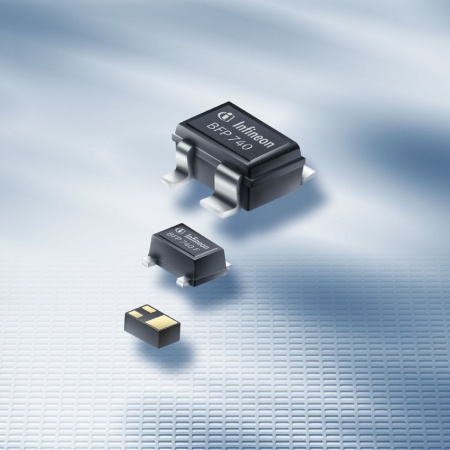Infineon Offers New Silicon-Germanium Carbon Technology Based RF Transistors with Extremely Low Noise Figures for Various Wireless Applications
Munich, Germany – August 31, 2005 – Infineon Technologies AG (FSE/NYSE: IFX) today unveiled its new SiGe:C (Silicon-Germanium Carbon) process technology for cost-effective, high-performance radio frequency (RF) semiconductor devices. The innovative SiGe:C technology is the foundation for Infineon’s latest generation of Heterojunction Bipolar Transistors (HBTs), which provide the world’s lowest noise figures for silicon-based discrete transistors of only 0.75 dB at 6 GHz and high gain of up to 19 dB at 6 GHz. With the introduction of the new BFP740 HBT family, Infineon achieves silicon-based performance levels that could previously be attained only by using more expensive technologies based on gallium arsenide (GaAs).
The new SiGe:C transistors are suitable for use in a wide range of RF and wireless applications using frequencies above 10 GHz, such as Low Noise Amplifiers (LNAs), microwave oscillators, and general-purpose amplifiers for various standards including Wireless LAN (802.11a, b, g), WiMAX, and Ultra Wide Band (UWB). Applications encompass Global Positioning Systems (GPS), cordless phones, satellite TV LNBs (Low Noise Blocks), and satellite-based broadcast services (e. g., XM Radio, Sirius, Digital Audio Broadcasting).
“The introduction of the BFP740 series is a further milestone in expanding Infineon’s high-performance RF transistor portfolio,” commented Michael Mauer, Head of Product Marketing, Silicon Discretes at Infineon Technologies. “These new HBTs give RF designers a dramatic boost in performance, while retaining the desirable features of low cost and manufacturability inherent in devices using traditional SMT packages. By addressing specific front-end requirements, such as low noise figures and high gain, the new RF transistors are the ideal solution for current and future wireless applications of 10 GHz or more.”
The new Infineon RF transistors have a typical transition frequency of 42 GHz and provide the lowest noise figure levels currently available in the SiGe:C market: 0.5 dB at 1.8 GHz and 0.75 dB at 6 GHz, respectively. With a typical Gms (maximum stable power gain) of 28 dB at 1.8 GHz, typical G ma (maximum available power gain) of 19 dB at 6 GHz and low current operation, these devices are ideal for a wide range of RF and wireless applications, such as WLANs. Infineon’s HBT chips feature gold metallization for extra high reliability.
The Silicon-Germanium Carbon Process Technology
Unique to Infineon’s Silicon-Germanium Carbon process technology is a significantly reduced base resistance, leading to the industry’s lowest noise figures for silicon- based discrete transistors. In addition, a novel method for drastically reducing parasitic ground inductance was developed. This unique grounding concept permits attainment of high-gain values at higher frequencies while still employing proven, low-cost industry-standard plastic packages.
Availability, Packaging
The BFP740 HBT series is in volume production and available in standard SOT343 (BFP740) packages, flatlead TSFP-4 (BFP740F) packages and ultra small 3-pin leadless TSLP-3 (BFR740L3) packages. The TSLP-3 package size is only 1.0 mm x 0.6 mm x 0.4 mm.
Further information on Infineon’s Silicon-Germanium Carbon technology-based transistors is available at: www.infineon.com/bfp740
Press Photo: Infineon's Heterojunction Bipolar Transistors (HBTs) which are based on its new Silicon-Germanium Carbon process technology provide the industry's lowest noise figures of silicon based discrete transistors. They are available in standard SOT343 (BFP740, top) packages, flatlead TSFP-4 (BFP740F, central) packages and ultra small 3-pin leadless TSLP-3 (BFR740L3, bottom) packages its size being only 1.0mm x 0.6mm x 0.4mm.
About Infineon
Information Number
INFAIM200508.084
Press Photos
-
 SiGe:C
SiGe:CJPG | 97 kb | 850 x 850 px
